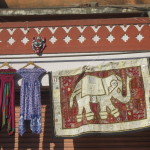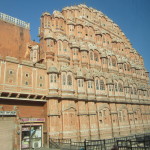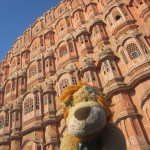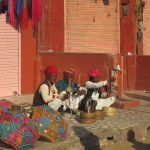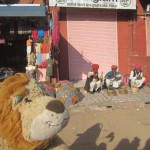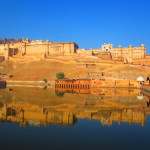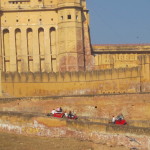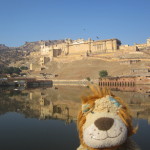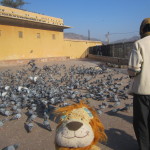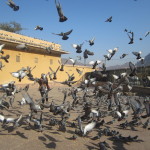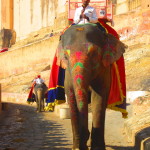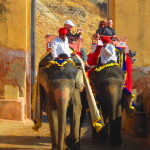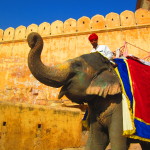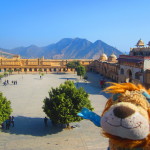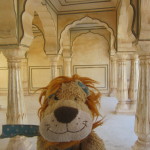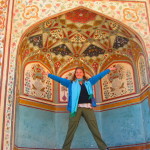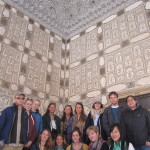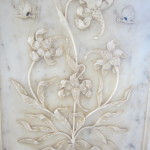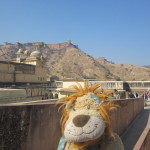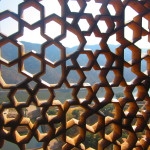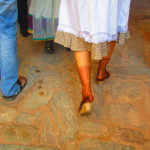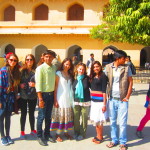- Elephants are all around in Jaipur
- The Hawa Mahal – the Palace of the Winds
- Lewis the Lion and the Palace of the Winds
- Snake charmers near the Hawa Mahal
- Lewis the Lion stands well back from the dancing cobras
- Lewis loves the little elephants
- The scenic Amer Fort
- The elephants carry tourists up the steep slopes to the fort
- Lewis admires the view over the lake to the Amer Fort
- Lewis learns about an Indian superstition
- Lewis’ friends enjoy running through the pigeons!
- The elephants are painted in bright colours
- Elephant rides up to the Amer Fort
- An elephant raises his trunk greeting Lewis the Lion
- Lewis the Lion overlooks the first courtyard of the Amer Palace
- Lewis cools off beneath the marble archways
- Lewis admires the mix of Hindu and Muslim architecture
- Helen poses in one of the colourful archways
- Hindu and Islamic designs combine
- The group have their photo taken through a mirror!
- How many parts of animals can you see in this picture?
- Lewis discovers that this place is enormous!
- Smelling the herbs in the Summer Garden
- Looking through a grid from the Summer Palace
- Lewis spots a bride whose had her feet decorated with henna
- The newly-weds want photos with Lewis the Lion’s friends!
After breakfast the next day, Lewis the Lion and his group of travellers set off for the ruined city of Amer (pronounced as Amber), former capital of Jaipur state. He was off to visit a most wonderous fort and palace complex.
However, before he got that far, the coach stopped off at one of the most photographed sites in India after the Taj Mahal – the sprawling Hawa Mahal: the Palace of Winds. Built in 1799, ‘hawa’ means breeze which would come through the windows, keeping the palace cool even on hot days. However, the only thing remaining of this former city-palace today is a vast, five storey, pink-coloured facade which has many small windows (953 to be exact). It was so designed so that the royal ladies behind the screen could observe everyday life on the street below without being seen. Lewis the Lion thought to himself, ‘I don’t want to be seen either!’ as not far from the facade were three snake charmers who were enticing cobras out of their baskets with their exotic music.
As the group got back on the bus after having a quick photo-stop, a woman selling strings of ceramic elephants and postcards wanted to sell her wares. Lewis the Lion rather liked the elephants as he could see their presence all around him and so he asked Helen if she’d mind buying him some? She managed to barter and got a very good deal for Lewis the Lion. He was very happy with this souvenir!
Before long, they were passing by the floating palace again as they headed towards the Amer Fort and Palace which was founded by the Meenas. This was a flourishing settlement back in 967 AD and Lewis the Lion as its scenic beauty and location took his breath away. Set high up overlooking the hills and the lake below, Lewis the Lion thought its tranquil beauty was a sight to behold. Meandering up through the fortress’ steep slopes he could see elephants carrying tourists to the top. They were highly decorated, painted in bright colours. However, after Lewis the Lion’s Thailand experience of elephant riding, he decided that it perhaps wasn’t such a kind thing to do and so decided to walk to the top with Helen instead. One of the elephant’s seemed to appreciate his gesture as it waved its trunk in greeting (a sign of good luck in India!).
On his way up to the top of the fort, he and his friends stopped in a little square to feed the pigeons. He learnt that an India superstition is that if you feed the birds or pigeons, you’ll never be out of money and you will always be approachable. At any rate, his friends had fun running through the mass of pigeons as they quickly swooped off and descended again!
Once at the top, Lewis had a fantastic vantage point overlooking a central courtyard. He found this place was filled with a deep calmness as he looked out over the mountains. They then had a tour of the palace with a tour guide called Mahesh. He told them many interesting facts about the design of the palace/fortress, notably that two fortresses are joined through well guarded secret passageways (Amer Fort and Jaigarh Fort) and that the style of the buildings are very unique as they are famous for their mix of Hindu and Muslim architecture.
Lewis the Lion especially liked the room of mirrors in the winter palace and Mahesh took a great photo of the group through a mirror – although it doesn’t look like that! Lewis the Lion learnt that the rulers liked to work out how smart their guests were by showing them cleverly designed marble images.
Did you know that there are 12 different parts of hidden animals in one of those pictures of a marble flower?
For example, rabbit’s ears, a scorpion, a fish, an elephant’s trunk, deer horns, butterflies, etc.
Can you find them all?
Lewis then was led out into another central courtyard. Around it was a hall for both a public and private audience and the rulers also had both a summer and a winter palace. He especially liked the balcony with their grids on the summer palace which would allow the breeze to come through, whilst you could look out without being seen. Looking down onto the moat, Lewis the Lion also learnt how the ruling family were very smart as they had developed special engineering to extract water from the moat, even during the summer months.
The former rulers, the Rajput Maharajas, used to have many wives who lived together (called a ‘harem’) and towards the back of the palace, each wife had a separate room (12 in all). They were inter-connected with secret tunnels so the ruler could move from one room to another without being noticed.
Beside this courtyard was a special herb garden. Lewis discovered a plant called tulsi which is a sacred plant in Hindu belief. He thought it was rather like a basil plant (it is in fact called ‘Holy Basil’) and he learnt that it has both religious and medicinal purposes, particularly to relieve stress and symptoms of fever, colds and infections.
As Lewis the Lion and the group were about to finish their visit to the fort, he spotted a woman in front of him had henna on her ankles that almost looked like she was wearing a pair of socks! He was curious to know more and so Helen asked why she had such beautiful designs on her feet and ankles. They discovered that she was a newly wed and was with her husband in Jaipur to celebrate. She then also showed Lewis the Lion that she had spectacular henna on her hands too. Lewis the Lion wondered if he would see any more of this whilst he was in India? For now, he wished the newly weds every happiness together in their married life.

